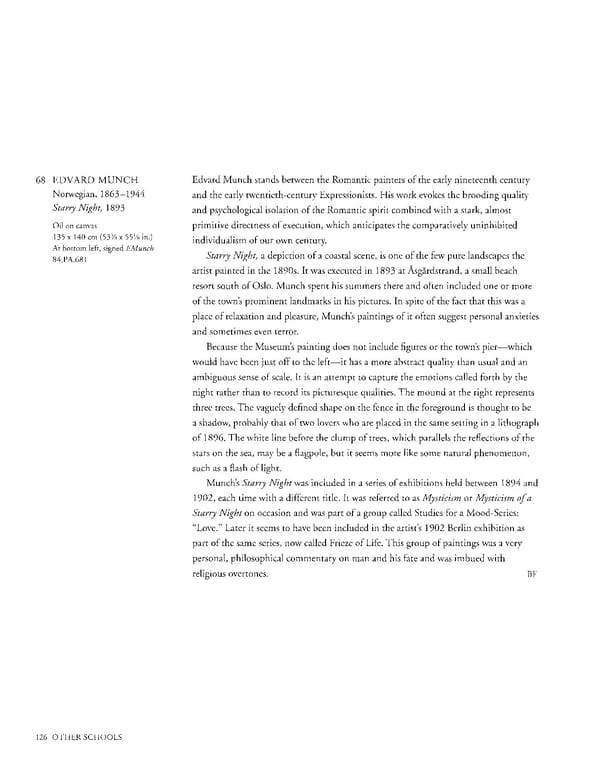68 EDVARD MUNCH Edvard Munch stands between the Romantic painters of the early nineteenth century Norwegian, 18631944 and the early twentiethcentury Expressionists. His work evokes the brooding quality Starry Night, 1893 and psychological isolation of the Romantic spirit combined with a stark, almost Oil on canvas primitive directness of execution, which anticipates the comparatively uninhibited 135 x 140 cm (53 x 55 in.) individualism of our own century. At bottom left, signed EMunch 84.PA.681 Starry Night, a depiction of a coastal scene, is one of the few pure landscapes the artist painted in the 1890s. It was executed in 1893 at Asgardstrand, a small beach resort south of Oslo. Munch spent his summers there and often included one or more of the towns prominent landmarks in his pictures. In spite of the fact that this was a place of relaxation and pleasure, Munch's paintings of it often suggest personal anxieties and sometimes even terror. Because the Museum's painting does not include figures or the town's pier—which would have been just off to the left—it has a more abstract quality than usual and an ambiguous sense of scale. It is an attempt to capture the emotions called forth by the night rather than to record its picturesque qualities. The mound at the right represents three trees. The vaguely defined shape on the fence in the foreground is thought to be a shadow, probably that of two lovers who are placed in the same setting in a lithograph of 1896. The white line before the clump of trees, which parallels the reflections of the stars on the sea, may be a flagpole, but it seems more like some natural phenomenon, such as a flash of light. Munch's Starry Night was included in a series of exhibitions held between 1894 and 1902, each time with a different title. It was referred to as Mysticism or Mysticism of a Starry Night on occasion and was part of a group called Studies for a MoodSeries: "Love." Later it seems to have been included in the artist's 1902 Berlin exhibition as part of the same series, now called Frieze of Life. This group of paintings was a very personal, philosophical commentary on man and his fate and was imbued with religious overtones. BF 126 OTHER SCHOOLS
 Masterpieces of the Getty Museum: Paintings Page 126 Page 128
Masterpieces of the Getty Museum: Paintings Page 126 Page 128